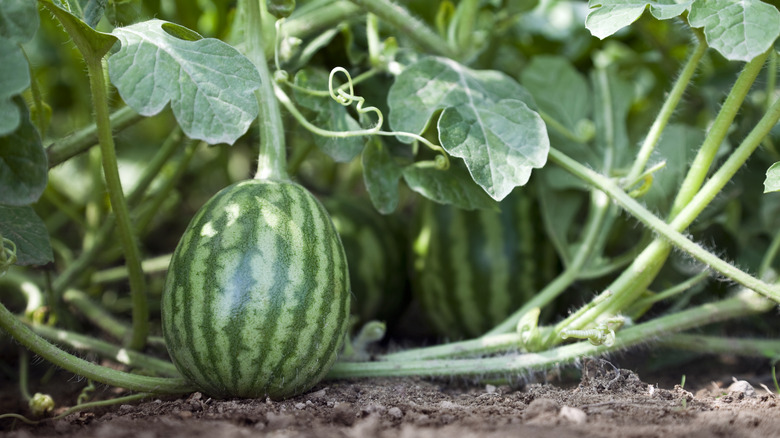How To Grow Watermelon From Seed For A Deliciously Juicy Harvest
There's nothing quite like a bite from a ripe watermelon to transport you back to the laid-back days of summertime. And while it may spark memories of warmer days, watermelon isn't just reserved for summer — in fact, it can grow in chillier climates with a bit of planning. No matter what season you are currently in, if you have a craving for a juicy, red watermelon, you can grow it from seed as long as your soil is at the right temperature, you plant the right type of watermelon, adhere to watermelon growing practices, and feed them appropriately.
While growing a watermelon from seed isn't necessarily difficult, you need to ensure you have all the right things in place, mainly your soil, which needs to be around 70 degrees Fahrenheit. Once your soil is ready, you don't have to do anything to prepare the watermelon seeds — they are good to place right into the ground as they are. You should sow watermelon seeds about 1 inch deep, planting them in mounds for better growth results. You should put about eight seeds in each mound and space the mounds 4 feet apart to allow space for the seeds to grow. Once your seeds are planted, here's how to ensure they sprout into that juicy watermelon you've been waiting for.
Tips for growing watermelon successfully
Before you start your harvest, you want to make sure you choose the right type of watermelon, which will vary by size. Some of the recommended options for DIY watermelon growers are the Sweet Beauty and the Sugar Baby. The next step is to prepare your soil. Watermelon seeds grow best in soil with a pH between 6.0 and 6.5. You can help get your soil to this pH level by adding well-rotted manure or compost. The soil should be well-drained, and if your ground is prone to excess water, using raised beds is a good solution.
Once the seed is planted, you want to keep the fruit watered, but not overly so, and avoid getting any leaves wet. When the seeds are still young, you'll want to try to water them about 1 to 2 inches per week. Installing a drip irrigation system is a recommended, albeit not necessary, option. Once you see fruit start to appear, you'll want to lower their water intake to keep the fruit from becoming dull or flavorless. Fertilizer, ideally one that is high in phosphorus, is also a good choice to ensure they continue to eat. Growing watermelon is a practice of patience, as it can take up to 100 days for the fruit to fully mature. You'll know your watermelons are ripe and ready to harvest when the fruit becomes a dull green, the rind is hard, or the ground spot turns yellow.
Troubleshooting issues that occur with growing watermelon
There are a lot of things to consider when planting fruit in your yard, and unfortunately, no matter how much you prepare and follow the steps, your watermelons can still be prone to issues. Weeds and not enough water in the soil are two of the main culprits of poor growth. To ensure this doesn't affect your watermelon, manage weeds by using organic mulch or plastic and ensure you are watering appropriately. You also don't want to rush the process — as previously mentioned, watermelons take time, and you cannot give up on them too soon or the end result will be less than ideal. Seedlings also need a lot of sun, so make sure you plant them in a spot that receives a good amount of direct sunlight.
Another big thing that can cause your watermelon to die or not grow properly is disease and pests. Aphids and cucumber beetles are common insects that can eat away at your growing melons. Get rid of them by using soap for aphids and applying chemicals for beetles as soon as you see them. As for disease, you can expect to see things like powdery mildew or wilt, which will make the plants sticky or have a slime-like texture. You can treat mildew on your watermelon with fungicides, while wilt is a bit more complicated and may require starting your crop cycle over again.


